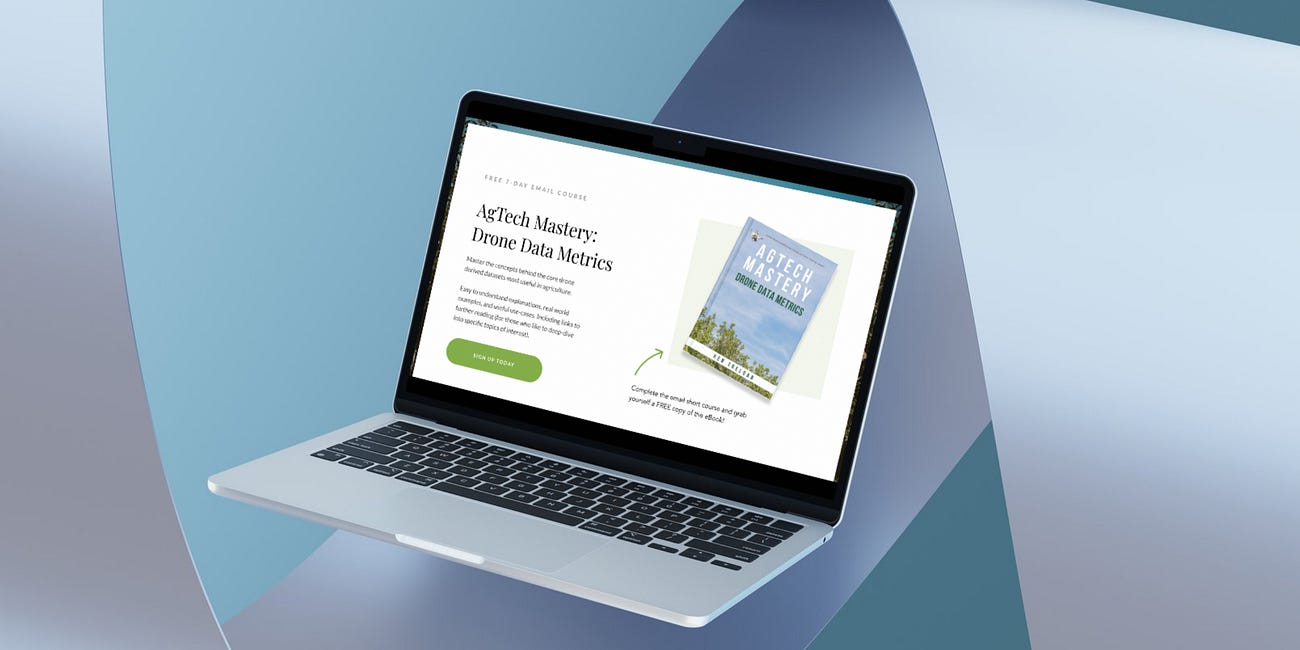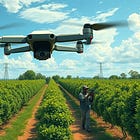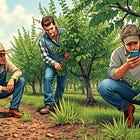Per-tree Sampling Methods: Historical Change Detection
Track orchard changes over time by focusing on the trees that matter most. Detect trends, validate interventions, and build data confidence season after season.
Some trees whisper. While others shout. The secret lies in knowing which ones to listen to. But how can we tell?
Introducing the power of historical change detection. An underrated return on investment in the realm of precise per-tree sampling.
Seeing the Story Over Time
Trees don’t exist in a snapshot. They’re part of a dynamic system. Shaped by weather, inputs, and management decisions. The most accurate insights don’t come from a single drone flight. They emerge when you track what’s changing over time.
Remote sensing and smart apps now provide recurring data with repeatable system processes. Geographic Information Systems (GIS) and analytic overlays are more accessible than every before. These allow us to compare seasons and orchards side by side, data layer by data layer, metric by metric.
It's not only about viewing trees for what they are now. But how they looked... how they've changed. And having enough data in hand to hazard a guess at what they will be like... with or without any interventions.
This is where per-tree sampling based on historical change becomes increasingly powerful. We can now focus limited in-field efforts on trees showing a meaningful change. Or adjust practices based on noted changes - whether positive or negative. Are trees declining rapidly or improving unexpectedly?
Remote sensing metrics tell a story worth investigating. The investigation tells a story of truth. And with each additional chapter, the storyline gets clearer and clearer.
Sample Where the Signal Is Strongest
Not all trees need the same level of attention.
Some are stable. Exactly what you would expect.
Some are spiralling on a downward trajectory.
While others are surging ahead. What could be the cause?
With tools like Aerobotics’ web platform, we can layer multispectral, canopy size, and thermal info across seasons. Compare current imagery against the same block from a year ago... or the year before that.
How about health vs canopy size?
Canopy size vs Transpiration?
Transpiration vs low and high spots in the orchard?
This lets us detect meaningful change at the individual tree level. Trees with consistent poor performance? That’s a red flag! Trees responding well and improving after pruning or input trials? That’s a data point worth noting, a confirmation of something going right!
Per-tree historical change metrics make it easier to:
Detect where interventions are working, or not.
Reduce scouting fatigue by pre-selecting high-value sampling points.
Correlate performance with past actions (like irrigation tweaks or pest treatments).
Justify variable-rate input decisions, adjustments, or further investigations.
Ground-Truth, Validate, and Iterate
Drone insights are only half the story. The real value comes when those insights are validated in the field.
Once you’ve flagged a tree, a group of trees, or an orchard zone showing change over time, use smart apps to log findings. Soil probes, pest traps, fruit counts, moisture meters... whatever the context, combine aerial metrics with ground-truth observations and telemetry outputs.
Author Louise Jupp puts it well in her book Precision Farming from Above:
“Sequential data obtained via agricultural drone surveying systems can be easily compared to reveal trends in the behaviour of soils and plants to specific conditions, treatments and farming practices. ...The value of these comparisons is enhanced when combined with traditional methods, such as detailed soil sampling to corroborate the drone supplied data and obtain more confidence in predicting the cause of problems or for defining more accurate variable rate prescriptions...”
This approach of analysing trends guides future activities with added clarity. Which gives us greater confidence in planning short, medium, and longterm actions.
Record keeping here is critical.
The more organised and time-stamped our records, the stronger our analysis becomes. Especially over time. This opens the door to ultra tailored precision VRA protocols. Enhanced irrigation planning. And pest and disease prevalence forecasting - with premeditated plans of action.
Case Studies from Forestry: Lessons for Farming
Interestingly, this approach is not limited to agriculture.
A study on ResearchGate titled "Tracking tree history to understand better natural dynamics of old-growth forest stands" used individual tree measurements to assess changes in height, canopy, and diameter over time.
The researchers combined drone imagery, manual measurements, and GIS tools to understand forest health and stand structure.
Their findings? Change detection at the tree level offered more actionable insights than random sampling alone.
Agriculture can learn from this. When change detection drives your sampling efforts, you’re no longer guessing. You’re prioritising. That’s how you make data manageable, and powerful.
Seasonal Context Matters
Don’t forget that timing plays a role. A tree might appear “in decline” only because it was surveyed during flowering or at peak crop load.
Historical comparisons should always be viewed with managerial, operational, and phenologically relevant seasonal context.
Were or are we irrigating?
Was or are there pest pressure?
Was flowering affecting canopy readings?
Is there a vegetative flush right now?
Are we in cell division stage, or oil accumulation?
Is this a period of root flush?
Where are we in relation to our pruning schedules?
Use field notes and app-based records to not only plan surveys, but add a vital layer of nuance. Yes, the goal is to track changes – but at the right time - and to also interpret the why behind the changes.
A Smarter Way to Scout
This is what per-tree historical change detection unlocks:
Efficient sampling.
Higher-confidence decisions.
Lowered labour costs / Efficient labour use.
Improved record keeping.
Continuous improvement year-on-year.
In an era where every input costs more... this kind of approach shifts the focus from more data to smarter data.
You don’t need to sample every tree, every time. You need to sample the right ones. And historical change detection helps you find them.
In closing, remember there are in essence three parts to change-detection sampling:
One is through taking initial action + general observation (drone survey + data reviews).
The second is follow-on action + acute observation (per-tree in-field sampling + data results).
Step 1 supports the actions of Step 2. Once repeated we have a robust record of changes. And the appropriate management takes place. This is Step 3.
Learn More: Free Course + eBook
This blog post forms part of the Smart Sampling section of the AgTech Diaries blog.
If you found it useful, sign up for the free Drone Data Metrics Email Course. You’ll get background info and practical tips for using per-tree and zonal data. Every subscriber gets the eBook too, covering key drone metrics for perennial crops.
👉 Sign up here to start learning.
Drone Data Metrics (Free email course)
If you want to learn more about the core sets of drone data you can utilise for enhancing agricultural efficiencies, this free course is for you!










